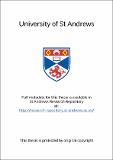Files in this item
Italian Renaissance collecting of Classical antiquities : Ferdinando de' Medici and the Villa Medici in Rome
Item metadata
| dc.contributor.advisor | Smith, Graham, 1942- | en |
| dc.contributor.author | Brandi, Cara | en |
| dc.coverage.spatial | 354p | en |
| dc.date.accessioned | 2021-04-08T08:59:33Z | |
| dc.date.available | 2021-04-08T08:59:33Z | |
| dc.date.issued | 2001 | |
| dc.identifier.uri | https://hdl.handle.net/10023/21944 | |
| dc.description.abstract | In 1569 Ferdinando de' Medici arrived in Rome to take up his position as Cardinal. Immediately upon his arrival he began to collect classical antique sculpture and by 1576 he had begun to transform a newly purchased property into a Roman suburban villa. The projects which Ferdinando undertook to transform his villa, which directly centred on the display of his antiquities collection, followed design and decorative traditions employed at other previous and contemporary villas and yet was also unusual. In this study four main design and decorative phenomena, including the statue gallery, the garden herms, the obelisk and the Niobe group, are studied in detail as part of Ferdinando's development of the Villa Medici in Rome. Ferdinando's objectives as an antiquities patron were shaped by the personal and political context of his role within the Medici family and its lineage, and his career in the Vatican. These elements are all drawn together to understand their impact on his development of the Villa Medici. As Ferdinando's transformation of the Villa Medici evolved over time, the existence of the statue gallery and garden herms reflected his early desire to create a property whose design and decoration could be compared with others like it in Rome, while also reflecting contemporary ideas developed outside of the city. In his use of an obelisk Ferdinando made clear associations with the urban renewal projects of Pope Sixtus V, and also made associations to his Florentine Medici lineage and Rome's ancient heritage. With the Niobe group, however, Ferdinando also began to define himself as one of the foremost patrons of antique sculpture in Rome. Ultimately, this study defines the purpose and meaning of Ferdinando de' Medici's antiquities collection and his development of the Villa Medici in Rome. | en |
| dc.language.iso | en | en |
| dc.publisher | University of St Andrews | en |
| dc.subject.lcc | NB85.M4B8 | |
| dc.subject.lcsh | Medici, House of--Art collections | en |
| dc.title | Italian Renaissance collecting of Classical antiquities : Ferdinando de' Medici and the Villa Medici in Rome | en |
| dc.type | Thesis | en |
| dc.type.qualificationlevel | Doctoral | en |
| dc.type.qualificationname | MPhil Master of Philosophy | en |
| dc.publisher.institution | The University of St Andrews | en |
This item appears in the following Collection(s)
Items in the St Andrews Research Repository are protected by copyright, with all rights reserved, unless otherwise indicated.

